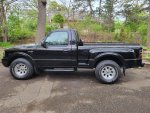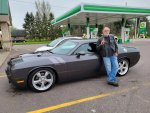I have the original spare from my 93, has about 100 miles or less. very weather cracked though even though it spends time out of the direct sunlight. The problem with older tires (even if they look good) is that something breaks down with the rubber over time, They wont be as grippy and can blow on you for no apparent reason. 2 cases in point:
(1) many years ago I bought a mint 93 taurus, only had 20K miles on it, original firestones. in wet weather you couldnt hardly get stopped without sliding tires and it didnt take much to lose traction from a stop. Absolutely horrible in winter, couldnt get a grip. after that first winter I put new tires on, made all the difference in the world.
(2) I had bought a used ranger for $500, at the time I was driving a ‘92 2wd with wheels that looked absolutely horrid, alloys that had seen a lot of salt and little to no care took of them, this 97 I had bought had decent deer-hoof rims, had been told it was vandalized once and the guy put junkyard tires on it. I didnt give it much thought as they held air and the tread looked good. I swapped the deer hoofs onto the 92 and a week or so later I was on the outskirts of town on a interstate, normally a 65 mph road. I was going around a semi when the left front let go- at about 65/70. Some how I completed the pass, got over to the side to change the tire (very little left ) Both fronts were the same so I took a good look at the date code, I knew they were old, hadnt seen uniroyal tiger paws in years. Turns out those fronts were new in 1986. Very old.
So be cautious about running old tires, I know my winter tires for the ranger are about 10 years old now but slip easily on wet pavement. tread looks ok, not weather cracked, decent brand too (bridgestone blizzacks) But I feel the rubber is hardning with age and they just dont grip like they used too.














